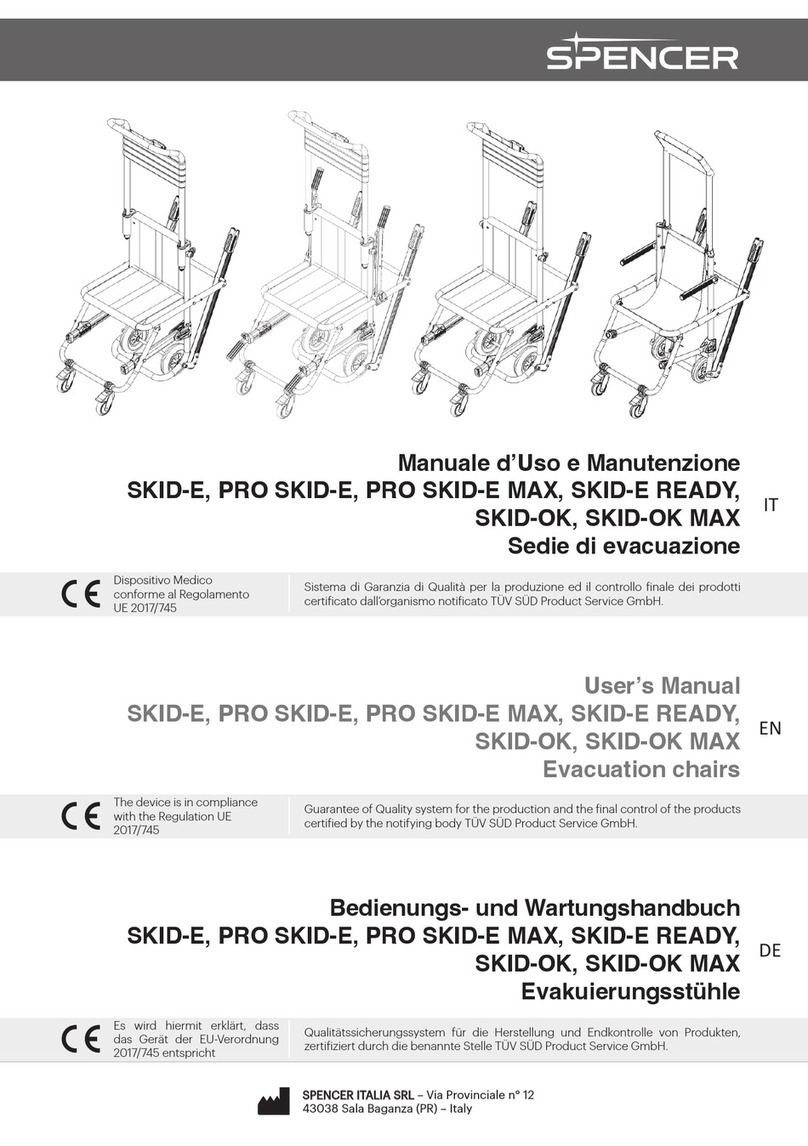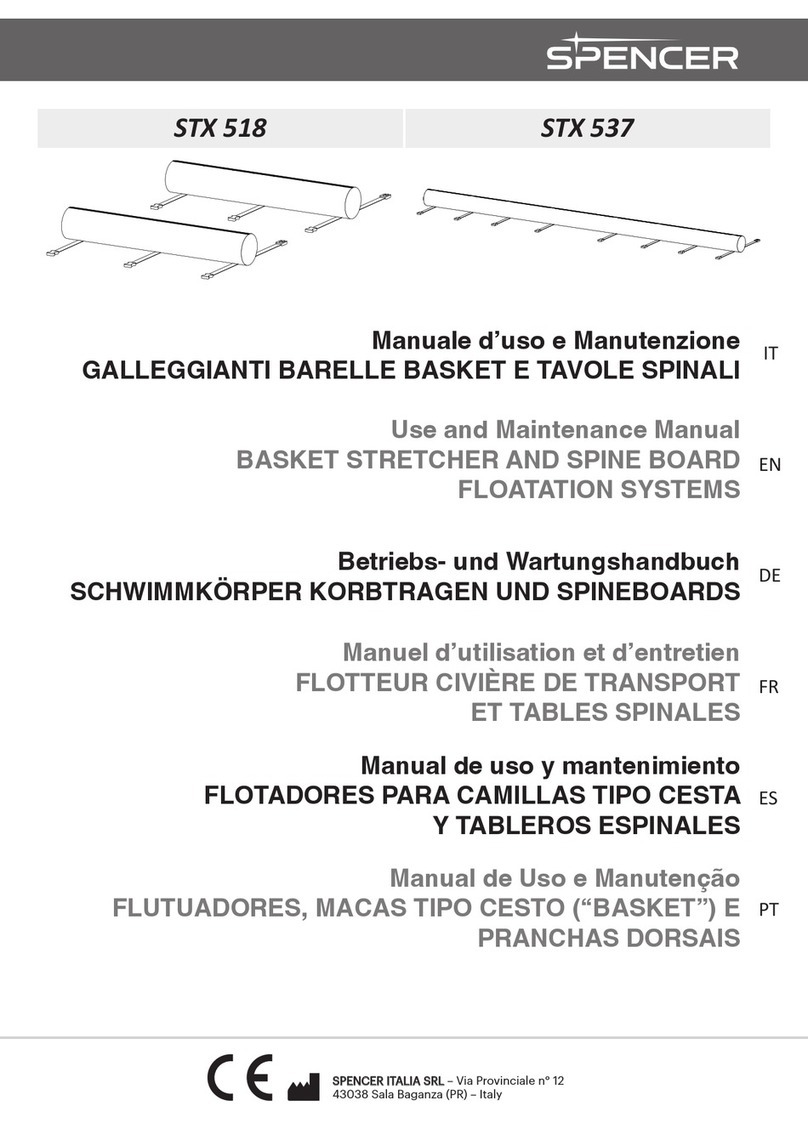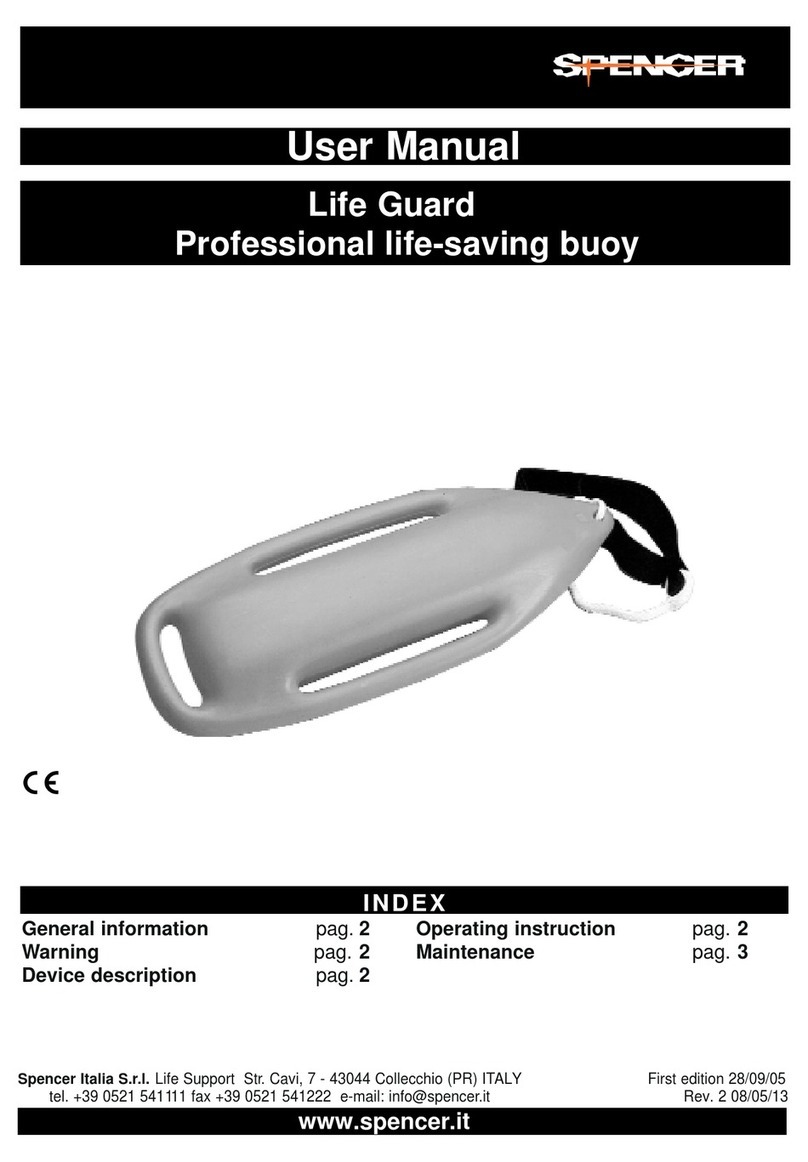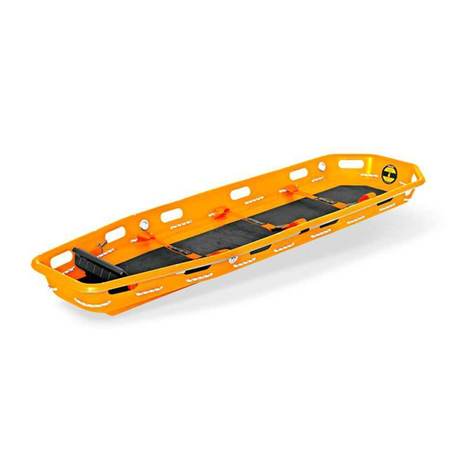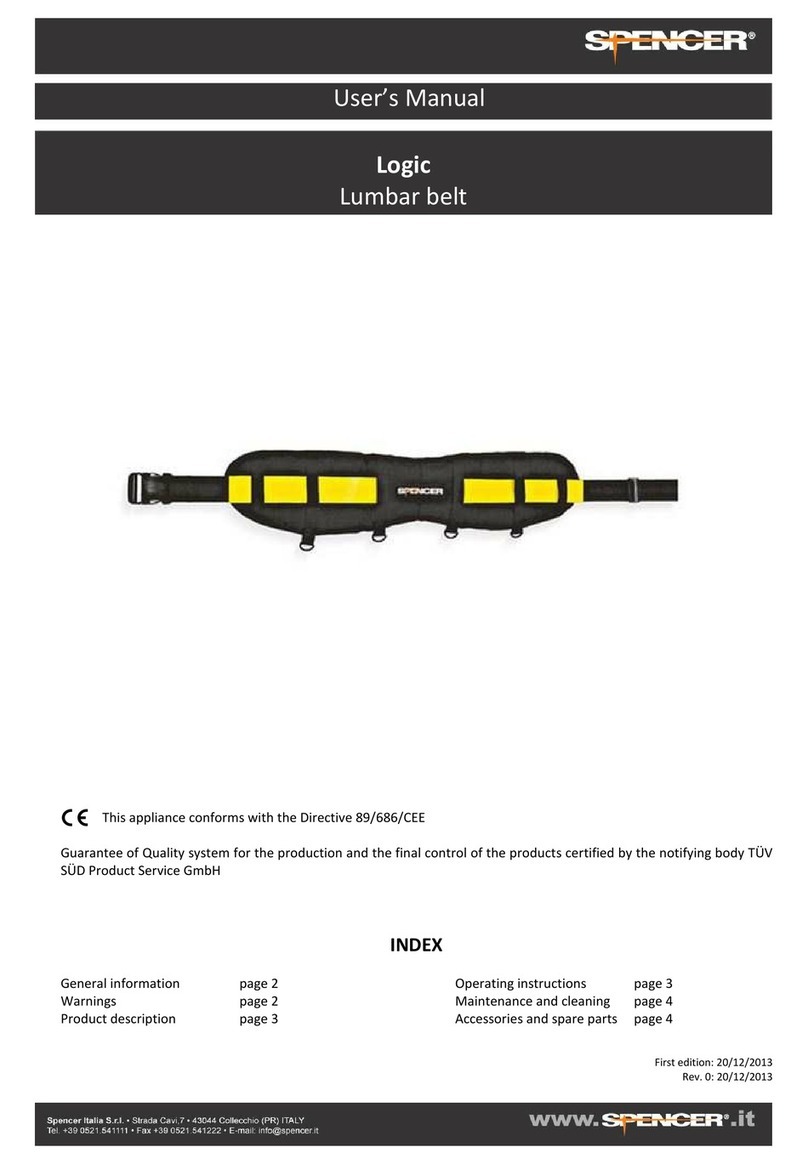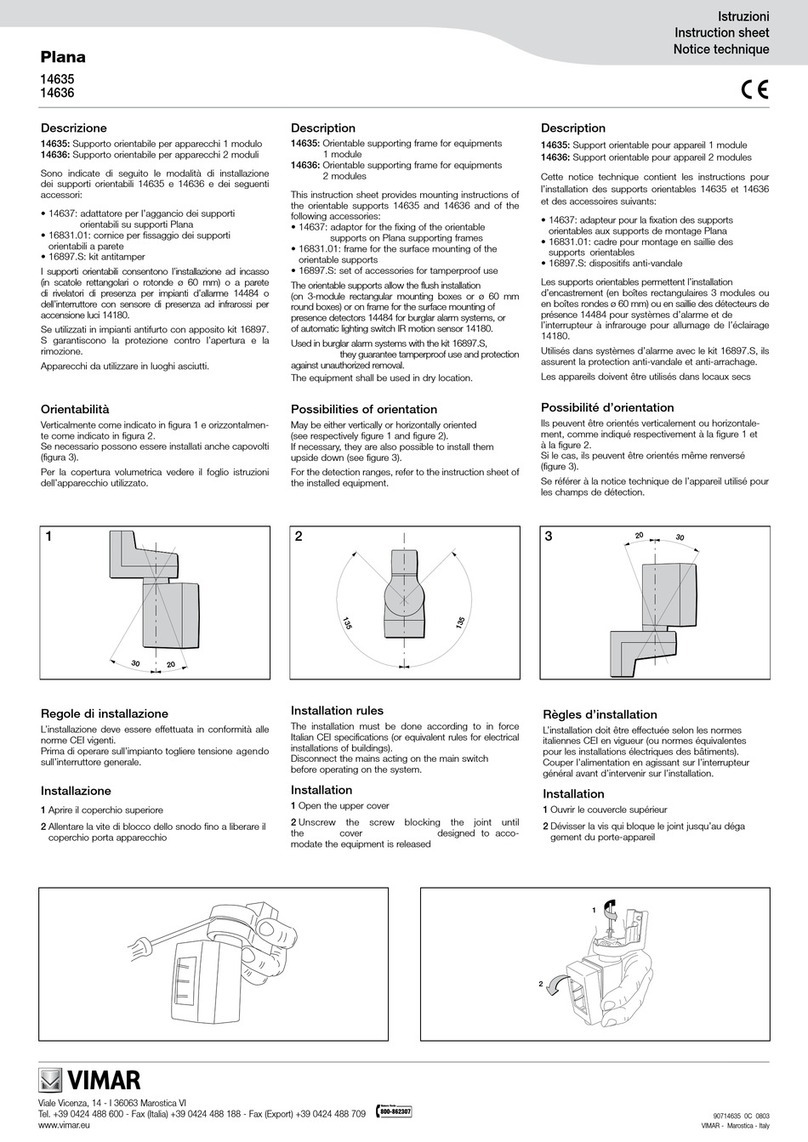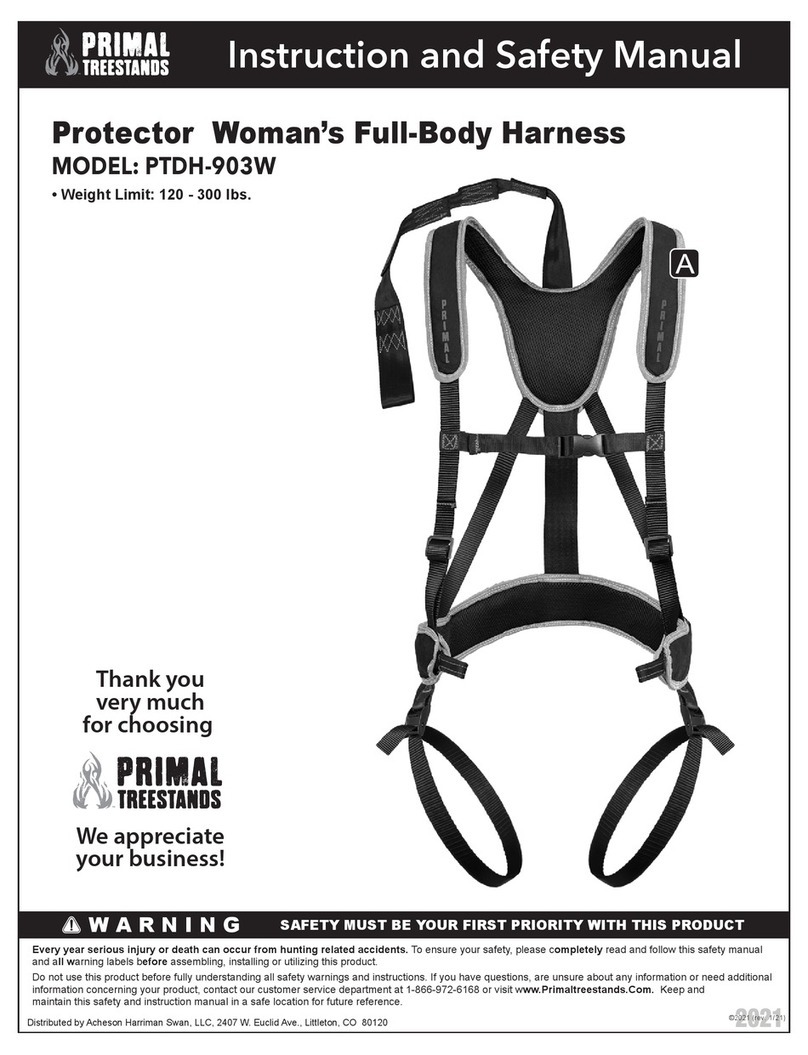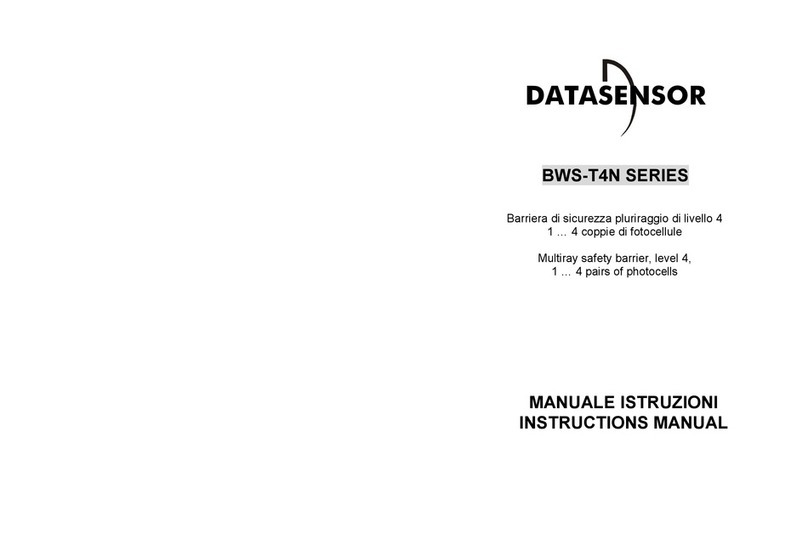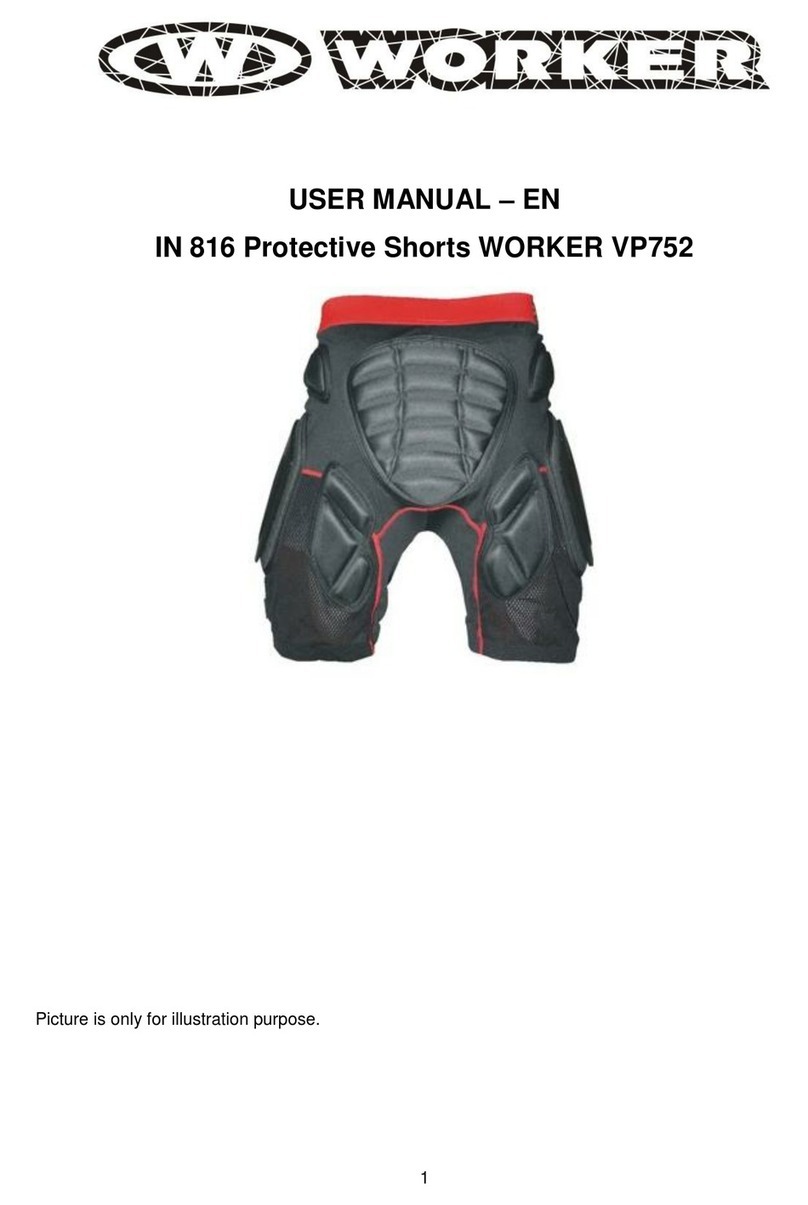Spencer FA User manual

1
Manuale d’Uso e Manutenzione
FA
Fissaggio anteriore per barelle
Si dichiara che il dispositivo è conforme alla Direttiva 93/ 2/CEE “Dispositivi Medici”
Sistema di Garanzia di Qualità per la produzione ed il controllo finale dei prodotti certificato
dall’organismo notificato TÜV SÜD Product Service GmbH
INDICE
Informazioni generali pag. 2
Avvertenze pag. 2
Descrizione del prodotto pag.
Istruzioni operative pag. 5
Manutenzione e pulizia pag. 7
Accessori e ricambi
pag. 8
Prima emissione: 03/03/03
Rev. 8: 26/09/2019
Spencer Italia s.r.l.
Tel. +39 0521.541111 / Fax +39 0521.541222 / e mail: info@spencer.it

2
Grazie per aver scelto un prodotto Spencer
1. INFORMAZIONI GENERALI
1.1 Scopo e contenuto
Questo manuale ha lo scopo di fornire al cliente tutte le informazioni necessarie affinché, oltre ad un
adeguato utilizzo del dispositivo, sia in grado di gestire lo strumento nel modo più autonomo e sicuro
possibile. Esso comprende informazioni inerenti l'aspetto tecnico, il funzionamento, la manutenzione,
i ricambi e la sicurezza.
1.2 Conservazione del manuale d’uso
Il Manuale d'uso e manutenzione deve essere conservato per tutta la durata del dispositivo in uso,
nelle vicinanze dello stesso, dentro un apposito contenitore e, soprattutto, al riparo da qualsiasi
elemento o sostanza che ne possa compromettere la perfetta leggibilità.
1.3 Simboli utilizzati
Simbolo Significato
Avvertenze generali e/o specifiche
Consultare istruzioni d’uso
Numero di lotto
Numero di matricola
Codice identificativo del prodotto
Prodotto conforme ai requisiti previsti nella Direttiva 93/ 2/CEE
1.4 Richiesta di assistenza
Per qualsiasi tipo di informazione relativa alla corretta interpretazione delle istruzioni, all'uso, alla
manutenzione, alla installazione, al reso, contattare il Servizio Assistenza Clienti Spencer tel. 0039
0521 5 1111, fax 0039 0521 5 1222, e-mail info@spencer.it oppure scrivere a Spencer Italia S.r.l.
– Via Provinciale, 12 - 3038 Sala Baganza (Parma) - ITALY.
Per agevolare le operazioni di
assistenza indicare o comunicare sempre il numero di matricola (SN) o lotto (LOT) riportato
sull’etichetta applicata sulla confezione o sul dispositivo stesso.
1.5 Smaltimento
Una volta inutilizzabili i dispositivi, qualora non siano stati contaminati da agenti particolari, possono
essere smaltiti come normali rifiuti solidi urbani, altrimenti attenersi alle norme vigenti in materia di
smaltimento.
1.6 Etichettatura
Ogni dispositivo viene dotato di un’etichetta, posizionata sul dispositivo stesso e/o sulla confezione,
nella quale compaiono i dati identificativi del Fabbricante, del prodotto, marcatura CE, numero di
matricola (SN) o lotto (LOT). Questa non deve essere mai rimossa o coperta.
2. AVVERTENZE
2.1 Avvertenze generali
•Il prodotto deve essere utilizzato solamente da personale addestrato all’utilizzo di questo
dispositivo e non di altri analoghi.
•La formazione deve essere registrata in un apposito registro, dove si specificano i nomi delle
persone formate, dei formatori, data e luogo. Tale documentazione, che attesterà l’idoneità degli
operatori all’utilizzo del dispositivo Spencer, dovrà essere mantenuta almeno per 10 anni dal fine
vita del dispositivo e dovrà essere messa a disposizione delle Autorità competenti e/o del
Fabbricante, quando richiesto.
•Spencer Italia S.r.l. si ritiene sempre a disposizione per lo svolgimento di corsi di formazione.
•Prima di effettuare qualsiasi operazione sul dispositivo (come formazione, installazione, impiego),
gli operatori devono leggere attentamente le istruzioni contenute nella presente pubblicazione,
con particolare attenzione riguardo alle opportune precauzioni per la sicurezza ed alle
metodologie d'installazione ed impiego.

3
•Nel caso in cui fossero presenti istruzioni d’uso relative ad altro dispositivo, diverso da quello
ricevuto, è necessario contattare immediatamente il Fabbricante prima di utilizzare il dispositivo.
•In caso di dubbi sulla corretta interpretazione delle istruzioni, interpellare Spencer Italia S.r.l. per
ottenere i necessari chiarimenti.
•Non consentire a persone non addestrate di aiutare durante l’uso del dispositivo, poiché
potrebbero causare lesioni al paziente o a se stessi.
•Effettuare la prescritta manutenzione e rispettare il tempo di vita medio, previsti dal Fabbricante
nel Manuale d'Uso.
•Prima di ogni utilizzo verificare sempre l’integrità del dispositivo come specificato nel manuale
d’uso. In caso di anomalie o danni che possano compromettere la funzionalità e la sicurezza del
dispositivo, quindi del paziente e dell’operatore, è necessario togliere immediatamente il
dispositivo dal servizio e contattare il Fabbricante.
•Nel caso di ravvisato malfunzionamento del dispositivo, è necessario utilizzare immediatamente
un prodotto analogo, al fine di garantire la continuità delle operazioni di soccorso.
•È vietato l’impiego del dispositivo per qualsiasi altro utilizzo diverso da quello descritto nel
presente manuale.
•Non alterare o modificare arbitrariamente il dispositivo; la modifica potrebbe provocarne il
funzionamento imprevedibile e danni al paziente o ai soccorritori.
•Il dispositivo non deve subire alcuna manomissione (modifica, ritocco, aggiunta, riparazione), in
caso contrario si declina ogni responsabilità sul funzionamento corretto o su eventuali danni
provocati dal dispositivo stesso; inoltre si rendono nulle la certificazione CE e la garanzia del
prodotto.
•Chi modifica o fa modificare oppure riappronta o fa riapprontare dispositivi medici in modo tale
che non servono più allo scopo previsto o non forniscono più la prestazione prevista deve
soddisfare le condizioni valide per la prima immissione in commercio.
•Maneggiare con cura.
•Assicurarsi di aver adottato ogni precauzione al fine di evitare pericoli derivanti dal contatto con
sangue o secreti corporei.
•Registrare e conservare con queste istruzioni: lotto, luogo e data di acquisto, data primo utilizzo,
data controlli, nome degli utilizzatori e commenti.
•Durante l'utilizzo del dispositivo deve essere garantita l'assistenza di personale qualificato.
•Non lasciare il paziente senza l’assistenza di almeno un operatore quando è in uso il dispositivo
medico.
•Non stoccare il dispositivo sotto altri materiali più o meno pesanti, che possano danneggiare la
struttura del dispositivo.
•Deve essere stoccato in luogo asciutto, fresco, al riparo dalla luce e non deve essere esposto al
sole.
•Stoccare e trasportare il dispositivo con la sua confezione originale.
•Il dispositivo non deve essere esposto, né venire in contatto con fonti termiche di combustione ed
agenti infiammabili.
•Posizionare e regolare il dispositivo in modo tale da non ostacolare le operazioni dei soccorritori e
l'utilizzo delle apparecchiature di soccorso.
•Attenzione: malgrado tutti gli sforzi, i test di laboratorio, i collaudi, le istruzioni d'uso, le norme
non sempre riescono a riprodurre la pratica, per cui i risultati ottenuti nelle reali condizioni di
utilizzo del prodotto nell'ambiente naturale possono differire in maniera talvolta anche rilevante.
Le migliori istruzioni sono la continua pratica d'uso sotto la supervisione di personale competente
e preparato.
•In riferimento al D. Lgs. 2 febbraio 1997, n. 6 emendato col D. Lgs. 25/01/2010, n. 37 –
Recepimento Direttiva 93/ 2/CEE e 2007/ 7/CE, si ricorda che gli operatori pubblici o privati, che
nell'esercizio della loro attività rilevano un incidente che coinvolga un dispositivo medico sono
tenuti a darne comunicazione al Ministero della salute, nei termini e con le modalità stabilite con
uno o più decreti ministeriali, e al Fabbricante. Gli operatori sanitari pubblici o privati sono tenuti
a comunicare al Fabbricante, ogni altro inconveniente che possa consentire l'adozione delle
misure atte a garantire la protezione e la salute dei pazienti e degli utilizzatori.
2.2 Avvertenze specifiche
•Stabilire un programma di manutenzione e controlli periodici, identificando un addetto di
riferimento. Il soggetto a cui viene affidata la manutenzione ordinaria del dispositivo deve
garantire i requisiti di base previsti dal Fabbricante, all’interno delle presenti istruzioni d’uso.
•Tutte le attività di manutenzione e revisione devono essere registrate e documentate con i relativi
report di intervento tecnico (vedere registro Manutenzione) le documentazione dovrà essere

4
mantenuta almeno per 10 anni dal fine vita del dispositivo e dovrà essere messa a disposizione
delle Autorità competenti e/o del Fabbricante, quando richiesto.
•Il dispositivo e tutti i suoi componenti, dopo il lavaggio, devono essere lasciati ad asciugare
completamente.
•Il dispositivo è dotato di sigilli di garanzia, se rimossi il Fabbricante non riconoscerà più la
garanzia del prodotto e declina ogni responsabilità sul funzionamento corretto o su eventuali
danni provocati dal dispositivo stesso.
•Seguire le procedure approvate dal Servizio Medico d’Emergenza per il posizionamento ed il
trasporto del paziente.
•Evitare il contatto con oggetti taglienti.
•Evitate forza eccessiva quando si carica la barella: una forza inutile può causare danni e può
influire negativamente sulle operazioni del carrello.
•Accumuli di polvere possono pregiudicare il corretto funzionamento del dispositivo.
•Un’installazione non adeguata del piano di carico può provocare un funzionamento anomalo del
dispositivo e arrecare danno al paziente ed utilizzatore
2.3 Controindicazioni ed effetti collaterali
L’utilizzo di questo dispositivo, se effettuato come descritto nel presente manuale d’uso, non
presenta particolari controindicazioni o effetti collaterali.
3. ZIONE DEL PR
2.4 Requisiti fisici degli operatori
Il fermo è un dispositivo destinato esclusivamente all’uso professionale. Trattandosi di accessorio
fondamentale per l’alloggiamento della barella in ambulanza, è necessario che gli operatori che lo
utilizzano abbiano i seguenti requisiti minimi:
•
capacità fisica nell’utilizzare il dispositivo
•
essere in grado di afferrare saldamente con entrambe le mani il dispositivo
•
presentare schiena, braccia e gambe robuste per alzare e sorreggere
•
possedere buona coordinazione muscolare
Ogni operatore deve essere addestrato per trasportare i pazienti in modo sicuro ed efficiente.
Per le tecniche di caricamento del paziente, per pazienti particolarmente pesanti, per interventi su
terreni scoscesi o in circostanze particolari ed inusuali si raccomanda la presenza di più operatori
(non solo 2 come previsto in condizioni standard).
Le capacità di ciascun operatore devono essere valutate prima della definizione dei ruoli
dei soccorritori nell’impiego del dispositivo.
3. DESCRIZIONE DEL PRODOTTO
3.1 Destinazione d’uso
Il fissaggio Fa Spencer è realizzato come ancoraggio anteriore per barelle Spencer. E’ stato
progettato solo per limitare gli spostamenti avanti, indietro e trasversali delle barella nel vano
sanitario dei veicoli di emergenza in condizioni normali di trasporto.
3.2 Componenti principali
1. Supporto fermo FA
2. Braccio guida dx
3. Braccio guida sx
. Vite TCEI M8x25 n° pz
5. Rondella ø8x2 n° pz
6. Dado M8 autobloccante n°8 pz
7. Vite TE M6x55 n° pz
8. Rondella ø6 n° pz
9. Rondella ø6x2 n° pz
10. Dado M6 autobloccante n° pz
11. Vite TE M8x50 n° pz
12. Rondella ø8 n° pz
13. Rondella ø8x32 n° pz
Fig. A

5
I componenti n° /5/6 sono necessari per il fissaggio tra Supporto fermo (1) e Bracci guida (2/3).
I componenti n° 7/8/9/10/11/12/13/6 sono necessari per il fissaggio tra FA e piano del mezzo.
3.3 Modelli
I modelli base riportati di seguito possono essere soggetti a modifiche, relative a codice e/o
descrizione, senza preavviso.
ST 2200A FA Fissaggio anteriore per barelle autocaricanti
3.4 Dati tecnici
Lunghezza 55 mm
Larghezza 30 mm (min) - 90 mm (max)
Altezza 73 mm
Peso 3 kg
Materiale Acciaio inossidabile e acciaio al carbonio
3.5 Standard di riferimento
Riferimento Titolo del documento
MDD 93/ 2/CEE Direttiva Europea concernente i Dispositivi Medici
MDD 2007/ 7/CEE
Modifica la Direttiva 90/385/CEE relativa agli
impiantabili attivi, direttiva 93/ 2/CEE concernente i
dispositivi medici e direttiva 98/8/CE relativi
all’immissione sul mercato dei biocidi
Decreto Legislativo 2 /02/1997, n. 6 Attuazione della Direttiva 93/ 2/CEE, concernente i
Dispositivi Medici
Decreto Legislativo 25/01/2010, n. 35 Modifiche ed integrazioni al decreto del 20/02/97 n. 6
UNI EN ISO 9001 Sistemi di gestione per la qualità: requisiti
UNI EN ISO 9000 Sistemi di gestione per la qualità - Fondamenti e
vocabolario
UNI EN ISO 13 85 Dispositivi medici - Sistemi di gestione della qualità -
Requisiti per scopi regolamentari
UNI EN ISO 1 971 Applicazione della gestione dei rischi ai dispositivi medici
UNI CEI EN 980 Simboli grafici utilizzati per l'etichettatura dei dispositivi
medici
UNI CEI EN 10 1 Informazioni fornite dal fabbricante di dispositivi medici
MEDDEV 2. /1a-b Guideline for the classification of medical devices
NB-MED 2.5.1 /Rec 5 Technical Documentation
MEDDEV 2.12/1 Medical Devices vigilance system
BS OHSAS 18001 Sistemi di gestione della sicurezza e della salute sul
luogo di lavoro
3.6 Condizioni ambientali
Temperatura di utilizzo: da -20 a +60 °C
Temperatura di stoccaggio: da -20 a +60 °C
Umidità relativa: da 5 a 85%
4. ISTRUZIONI OPERATIVE
4.1 Trasporto e stoccaggio
Prima di effettuare il trasporto del dispositivo assicurarsi di averlo imballato adeguatamente e di
essersi adoperati affinché non sussistano rischi di urti o cadute durante il trasporto stesso.
Conservare l’imballo originale per eventuali successivi trasporti e per lo stoccaggio.
Danni al dispositivo causati durante il trasporto e la movimentazione non sono coperti da garanzia.
Riparazioni o sostituzioni di parti danneggiate sono a carico del cliente.
Lo stoccaggio del dispositivo deve avvenire in un luogo asciutto, fresco, al riparo dalla luce e dal
sole. Non deve entrare in contatto con fonti di comustione ed agenti infiammabili e/o sostanze,
agenti chimici, che potrebbero alterarne le caratteristiche di sicurezza.
4.2 Preparazione
Al ricevimento del prodotto:
•
Rimuovere l’imballo e disporre il materiale in modo visibile.

6
Fig. B Fig. C
•
Controllare che siano presenti tutti i pezzi compresi nella lista di accompagnamento.
•
Fissare il supporto fermo FA con i bracci guida mediante la viteria in dotazione n° /5/6 (vedi
paragrafo 3.2), avvitare il tutto fino al completo serraggio.
Il dispositivo va controllato prima di ogni messa in servizio, in modo da poter rilevare anomalie di
funzionamento e/o danni dovuti al trasporto e/o immagazzinamento. In particolare verificare:
•
Funzionalità generale del dispositivo
•
Stato di pulizia del dispositivo (si ricorda che la mancata esecuzione delle operazioni di pulizia
può comportare il rischio di infezioni crociate)
•
Assenza di tagli, fori, lacerazioni o abrasioni sull’intera struttura
•
Corretto serraggio della viteria e bulloneria
•
Stato di usura (parti in movimento)
•
Integrità componenti
•
Scatto delle molle
•
Accertarsi che premendo la leva di comando, avvenga lo sblocco della slitta di movimentazione
Se le condizioni riportate sono rispettate, il dispositivo può essere considerato pronto all'uso; in caso
contrario è necessario togliere immediatamente il dispositivo dal servizio e contattare il Fabbricante.
4.3 Requisti del veicolo di emergenza
Spencer FA è progettato per essere installato nel vano sanitario di un'ambulanza. Il veicolo deve
possedere i seguenti requisiti:
•
Piano di calpestio livellato
•
Piano di calpestio sufficientemente largo e lungo per alloggiare senza ostacoli il fermo
•
Al fine di garantire un uso corretto del sistema di fissaggio si consiglia di installarlo su un veicolo
di emergenza che abbia le necessarie caratteristiche di tenuta, in base a quanto installato su di
esso
•
Presenza di un fermo posteriore Spencer FP
4.4 Funzionamento
4.4.1 Fissaggio fermo al piano
1. Posizionare il fermo sul piano ambulanza, dove si ha intenzione di fissarlo.
2. Utilizzare il fermo come dima di foratura, evidenziando sul piano i fori da realizzare. É necessario
fare obbligatoriamente otto fori, quattro per il supporto fermo e due per ciascun braccio guida.
3. Fissare l'insieme costituito per mezzo delle viti in dotazione n°7/8/9/10/11/12/13/6 (vedi
paragrafo 3.2).
4.4.2 Posizionamento barella sul fermo
1. Caricare la barella nel vano sanitario del veicolo di emergenza, spingendola fino al contatto con il
fermo, come in fig. B
2. La barella verrà convogliata automaticamente, come in fig. A
3. Verficare la stabilità e la sicurezza del fissaggio.
Per ottenere un fissaggio corretto è obbligatorio prevedere anche il fissaggio posteriore
Spencer FP.

7
4.5 Tabella gestione guasti
PROBLEMA CAUSA RIMEDIO RISCHIO RESIDUO
Lesioni alla
struttura
Uso improprio Mettere immediatamente il
gancio fuori servizio e
contattare il centro di
assistenza o il fabbricante
Nessuno
5. MANUTENZIONE E PULIZIA
5.1 Pulizia
La mancata esecuzione delle operazioni di pulizia può comportare il rischio di infezioni crociate
dovute alla presenza di secreti e/o residui.
Durante tutte le operazioni di controllo e igienizzazione l’operatore deve indossare
adeguati dispositivi di protezione individuali, quali guanti, occhiali etc.
Le parti metalliche esposte agli agenti esterni subiscono trattamenti superficiali e/o verniciatura al
fine di ottenere una migliore resistenza.
Lavare le parti esposte con acqua tiepida e sapone neutro; non usare mai solventi o smacchianti.
Nel caso di eventuale disinfezione utilizzare prodotti che non abbiano azione solvente o corrosiva su
materiali costituenti il dispositivo.
Si consiglia inoltre l'uso del detergente lucidante Spencer STX 99.
Risciacquare accuratamente con acqua tiepida verificando di avere eliminato ogni traccia di
detergente, che potrebbe deteriorarla o comprometterne l’integrità e la durata.
L'uso di acqua ad alta pressione deve essere evitato. L'acqua infatti penetra nei giunti ed elimina il
lubrificante creando il rischio di corrosione dei componenti.
Lasciare asciugare perfettamente prima di riporlo. L’asciugatura dopo il lavaggio oppure dopo
l’utilizzo in ambiente umido deve essere naturale e non forzata; non utilizzare fiamme o altre fonti di
calore diretto.
5.2 Manutenzione
Stabilire un programma di manutenzione e controlli periodici, identificando un addetto di riferimento.
Il soggetto a cui viene affidata la manutenzione del dispositivo deve garantire i requisiti di base
previsti dal Fabbricante nei paragrafi successivi.
Tutte le attività di manutenzione devono essere registrate e documentate con i relativi report di
intervento tecnico. Tale documentazione dovrà essere mantenuta almeno per 10 anni dal fine vita
del dispositivo e dovrà essere messa a disposizione delle Autorità competenti e/o del Fabbricante,
quando richiesto.
In riferimento al D. Lgs. 2 febbraio 1997, n. 6 emendato col D. Lgs. 25/01/2010, n. 37 –
Recepimento Direttiva 93/ 2/CEE e 2007/ 7/CE, si ricorda che gli operatori pubblici o privati, che
nell'esercizio della loro attività rilevano un incidente che coinvolga un dispositivo medico sono tenuti
a darne comunicazione al Ministero della salute, nei termini e con le modalità stabilite con uno o più
decreti ministeriali, e al Fabbricante. Gli operatori sanitari pubblici o privati sono tenuti a comunicare
al Fabbricante, ogni altro inconveniente che possa consentire l'adozione delle misure atte a garantire
la protezione e la salute dei pazienti e degli utilizzatori.
5.2.1 Manutenzione ordinaria
Il soggetto a cui viene affidata la manutenzione ordinaria del dispositivo deve garantire i seguenti
requisiti di base:
•
Conoscenza tecnica del dispositivo, delle operazioni di manutenzione periodica stabilite in queste
istruzioni.
•
Utilizzo per le operazioni di manutenzione di personale tecnico in possesso di specifiche
qualifiche, addestramento e formazione sul dispositivo in oggetto.
•
Utilizzo di materiali di componenti/parti di ricambio/accessori originali o approvati dal fornitore
(se previsti), in modo da effettuare ogni operazione senza causare alterazioni, modifiche al
dispositivo.
•
Possesso di sistemi di controllo e verifica delle operazioni svolte sul dispositivo.
•
Assicurare il pieno rispetto delle prescrizioni della Direttiva 93/ 2/CEE anche in ordine agli
obblighi verso il Fabbricante per consentire a quest’ultimo la sorveglianza post-vendita e la
rintracciabilità in ogni momento dei dispositivi.

8
Durante tutte le operazioni di controllo, manutenzione ed igienizzazione l’operatore deve
indossare adeguati dispositivi di protezione individuali, quali guanti, occhiali, etc.
I controlli da effettuare prima e dopo ogni messa in servizio, ed almeno ogni 2 mesi, sono i
seguenti:
•
Funzionalità generale del dispositivo
•
Stato di pulizia del dispositivo (si ricorda che la mancata esecuzione delle operazioni di pulizia
può comportare il rischio di infezioni crociate)
•
Corretto serraggio della viteria e bulloneria
•
Integrità componenti
La frequenza dei controlli è determinata da fattori quali le prescrizioni di legge, il tipo di
utilizzo, la frequenza di utilizzo, le condizioni ambientali durante l’uso e lo stoccaggio.
Si ricorda che è necessario effettuare la pulizia descritta al paragrafo 5.1 e la verifica della
funzionalità prima e dopo ogni utilizzo. Spencer Italia S.r.l. declina ogni responsabilità sul
funzionamento corretto o su eventuali danni provocati al paziente o all’operatore dall’utilizzo di
dispositivi non soggetti a manutenzione ordinaria, invalidandone la garanzia e facendo decadere la
conformità alla Direttiva 93/ 2/CEE Dispositivi Medici
5.2.2 Revisione periodica
Il dispositivo deve essere sottoposto a revisioni annuali per accertarne il corretto funzionamento e il
rispetto dei requisiti di sicurezza garantiti dal Fabbricante al momento dell’immissione in commercio.
Le revisioni devono essere effettuate dal Fabbricante, che si avvale di Tecnici interni ed esterni
specializzati ed abilitati dal Fabbricante stesso. In mancanza di tali revisioni annuali, il dispositivo
deve essere SEGREGATO FINO AL RIPRISTINO, diversamente deve essere SMALTITO E NE DEVE
ESSERE DATA COMUNICAZIONE AL FABBRICANTE.
Per gli interventi non effettuati dal Fabbricante, ma da un centro autorizzato, vi ricordiamo che è
necessario richiedere un report relativo all’attività svolta. Questo permetterà sia a Spencer Italia
S.r.l. che all’utilizzatore di tracciare nel tempo tutti gli interventi effettuati.
5.2.3 Tempo di vita
Il dispositivo, se utilizzato come riportato nelle seguenti istruzioni, ha un tempo di vita medio di 5
anni dalla data di acquisto, prorogabile in seguito a revisioni annuali.
Il tempo di vita può essere prorogato, ad insindacabile giudizio del Fabbricante o centro autorizzo,
qualora fossero ancora garantiti i requisiti di sicurezza del dispositivo.
In mancanza di tali proroghe, il dispositivo deve essere SMALTITO E NE DEVE ESSERE DATA
OMUNICAZIONE AL FABBRICANTE.
Spencer Italia S.r.l. declina ogni responsabilità sul funzionamento non corretto o su eventuali danni
provocati dall’utilizzo di dispositivi non revisionati dal Fabbricante o centro autorizzato, o che
abbiano superato il tempo di vita massimo ammesso
5.2.4 Manutenzione straordinaria
La manutenzione straordinaria può essere eseguita solo dal Fabbricante o da centri
autorizzati dal Fabbricante stesso.
Per gli interventi non effettuati dal Fabbricante, ma da un centro autorizzato, vi ricordiamo che è
necessario richiedere un report relativo all’attività svolta. Questo permetterà sia a Spencer Italia
S.r.l. che all’utilizzatore di tracciare nel tempo tutti gli interventi effettuati.
6. ACCESSORI E RICAMBI
Non sono previsti ne accessori ne ricambi per questo prodotto.

9
ALLEGATO A – REGISTRO DELLA FORMAZIONE
Il prodotto deve essere utilizzato solamente da personale addestrato all’utilizzo di questo dispositivo
e non di altri analoghi.
Conservare il presente registro almeno 10 anni dal fine vita del dispositivo.
Nome
operatore
Data della formazione Metodo di formazione
(manuale del
proprietario, in
serivizio, classe
formale, ecc.)
Formatore
Formazione
di base
Corso di
aggiornamento

10
ALLEGATO B – REGISTRO DELLA MANUTENZIONE
Conservare ill presente registro almeno 10 anni dal fine vita del dispositivo.
Effettuare la prescritta manutenzione e rispettare il tempo di vita medio, previsti dal Fabbricante nel
Manuale d'Uso.
Codice e descrizione dispositivo
Data di acquisto
Lotto (LOT) o matricola (SN)
Acquistato da
DATA
INTERVENTO
TIPOLOGIA
INTERVENTO
(manutenzione/
revisione/
estensione tempo di
vita)
OPERAZIONI ESEGUITE ESITO
RESPONSABILE
INTERVENTO
(interno/centro
autorizzato/
fabbricante)
Le informazioni contenute in questo documento sono soggette a modifica senza preavviso e sono da intendersi come impegno
da parte della Spencer Italia S.r.l. con riserva di modifiche. I prodotti Spencer vengono esportati in molti paesi nei quali non
valgono sempre identiche regole. Per questa ragione possono esserci differenze fra quanto qui descritto ed i prodotti
consegnati. Spencer lavora costantemente al perfezionamento di tutti i tipi e modelli dei prodotti venduti. Contiamo perciò
sulla Vostra comprensione se dovessimo riservarci la facoltà di apportare in qualsiasi momento modifiche alla fornitura nella
forma, equipaggiamento, allestimento e tecnica rispetto a quanto qui convenuto.
© Copyright Spencer Italia S.r.l.
Tutti i diritti sono riservati. Nessuna parte del documento può essere fotocopiata, riprodotta o tradotta in un’altra lingua senza
previo consenso scritto della Spencer Italia S.r.l.

11
User’s Manual
FA
Anterior fixation for stretchers
This appliance conforms with the Directive 93/ 2/CEE “Medical Devices”
Guarantee of Quality system for the production and the final control of the products certified by
the notifying body TÜV SÜD Product Service GmbH
INDEX
General information page 12
Warnings page 12
Description of product page 1
Operating instructions page 15
Maintenance and cleaning page 17
Accessories and spare parts
page 18
First edition: 03/03/03
Rev. 8: 26/09/2019
Spencer Italia s.r.l.
Tel. +39 0521.541111 / Fax +39 0521.541222 / e mail: info@spencer.it

12
Thank you for choosing a Spencer product
1. GENERAL INFORMATION
1.1 Aim and contents
The aim of this manual is to supply all the information necessary so that the client, will not only
attain adequate use of the appliance, he will also be capable of using the instrument in the most
autonomous and secure way possible. This includes information regarding technical aspects,
functioning, maintenance, spare parts and safety.
1.2 Conservation of the instruction manual
The instruction and maintenance manual must be kept together with the product, for the whole life
of the device, inside the specially provided container and above all, away from any substances or
liquids which could compromise perfect legibility.
1.3 Symbols used
Symbol Meaning
General or specific warning
See instructions for use
Lot number
Serial number
Product code
The product is compliant with the specifications of the Directive 93/ 2/CEE
1.4 Servicing requests
For any information regarding the use, maintenance and installation, please contact the Spencer
write to Spencer Italia S.r.l. – Via Provinciale, 12 - 3038 Sala Baganza (Parma) - ITALY. In order to
facilitate the assistance service, please always indicate or communicate the serial number (SN) or
lot number (LOT) shown on the label applied on the box or on the device.
1.5 Demolition
Follow the current regulations.
When the devices are no more suitable for being used, if they haven’t been contaminated by any
particular agents, they can be disposed of as normal solid waste, otherwise follow the current
regulations about demolition.
1.6 Labelling
Each device has got an identifying label, positioned on the device itself and/or on the box. This label
includes information about the Manufacturer, the product, CE mark, lot number (LOT). It must never
be removed or covered.
2. WARNINGS
2.1 General warnings
•The product must be used by trained personnel only, having attended specific training for this
device and not for similar products.
•Training routines must be registered on a special register in which the names of those trained, of
the trainers, date and place are indicated. This register which will certify the eligibility of the
operators to use the Spencer device has to be kept for a period of 10 years after the disposal of
the device itself. This register will be made available to the Competent Authorities and/or
Manufacturer if requested.
•Spencer Italia S.r.l. is always available for conducting training courses.
•Before carrying out any kind of operation on the appliance (training, installation, use), the
operator must carefully read the enclosed instructions, paying particular attention to the correct
safety precautions and to the procedures to be followed for installation and for correct use.
•If the instructions belong to another device and not the device received, inform the Manufacturer
immediately and avoid use of the device.

13
•In the case of any doubts as to the correct interpretation of the instructions, please contact
Spencer Italia S.r.l. for any necessary clarifications.
•Do not allow untrained personnel to help when using the device as they may cause injury to the
patient or themselves.
•Perform the required maintenance and to respect the life span of the device, as indicated by the
Manufacturer in the User’s Manual.
•Before each use of device the perfect operating state of the device must be checked as specified
in the Instruction manual. If any damage or abnormalities which could in any way influence the
correct functioning and the safety of the device, of the patient and or of the user are detected,
the device must be immediately removed from service and the Manufacturer must be contacted.
•If any failure or incorrect functioning of the device is detected, it must be immediately substituted
with a similar item so that the rescue procedures are guaranteed without any interruption.
•Use of the device in anyway other than described in this manual is forbidden.
•Do not alter or modify in any way the appliance; any such interference could cause malfunctions
and injury to the patient and/or rescuer.
•The appliance must not in any way be tampered with (modification, adjustment, addition,
replacement). In such cases all responsibility will be denied for any malfunctions or injuries
caused by the appliance itself; moreover CE certification and product warranty will be considered
void.
•Those who modify or have modified, prepare or have prepared medical appliances in such a way
that they no longer serve the purpose for which they were intended, or no longer supply the
intended service, must satisfy the valid conditions for the introduction onto the market.
•Handle with care.
•Ensure that all the necessary precautions are taken in order to avoid the hazards that can arise
as the result of contact with blood or body fluids.
•Register and store with these instructions: lot number, place and date of purchase, first date of
use, date of checks, name of users, any comments.
•When the device is being used, the assistance of qualified staff must be guaranteed.
•Never leave an unassisted patient. The presence of at least one operator is essential at all times
when the medical device is in use.
•Do not store the device underneath any heavy objects which could cause structural damage.
•Store in a cool, dry, dark place and do not expose to direct sun.
•Store and transport device in its original packaging.
•The device not be exposed to or come into contact with any source of combustion or inflammable
agents.
•Position and adjust the device taking care not to cause any obstruction to rescuers and or any
other rescue equipment.
•Attention: laboratory testing, post production tests, instruction manuals cannot always consider
every possible scenario for use. This means that in some cases the performance of the product
could be notable different from results to date obtained. Instructions are continually being
updated and are under tight surveillance of fully qualified staffs with adequate technical
formation.
•With reference to the D. Lgs. 2
th
February 1997, n. 6 emended by D. Lgs. 25/01/2010, n. 37 –
Acknowledgement of Directive 93/ 2/CEE and 2007/ 7/CE, we remind both public and private
operators that they are obliged to report any accident that involves any medical device to the
Ministry of Health and to the Manufacture as specified and within time given by the European
regulations.
In addition, both public and private operators are obliged to inform the Manufacturer of any
measures that should be adopted to make the steps necessary to guarantee the safety and the
health of the patients and the users o any medical device.
2.2 Specific warnings
•Establish a maintenance program and periodic testing, identifying an reference employee. The
person to whom the ordinary maintenance of the device is entrusted must ensure the basic
requirements foreseen by the Manufacturer in the user’s manual.
•Training routines must be registered on a special register in which the names of those trained, of
the trainers, date and place are indicated. This register which will certify the eligibility of the
operators to use the Spencer device has to be kept for a period of 10 years after the disposal of
the device itself. This register will be made available to the Competent Authorities and/or
Manufacturer if requested.
•The device and all its components, after washing, should be allowed to dry completely before
storing.

14
•The device has seals. If they have been removed or tampered with the Manufacturer declines any
responsibility for the product and for its correct functioning and for any consequent damage that
may occur to the device.
•Follow the procedures approved by the Emergency Medical Services for recovery and transport of
the patient.
•Avoid contact with sharp objects.
•Avoid excessive force when loading a stretchers: an excessive force may cause damage and can
adversely influence operations.
•Accumulations of dust can impair correct device operation.
•An inadequate installation of loading plan may cause undesired functioning of the device and
harm patient and user
2.3 Contraindications and side effects
The use of this device, if used as described in this manual, does not present any contraindications or
collateral effects.
4. ZIONE DEL PR
2.4 Physical requirements of the operators
The fastening system is a device designed exclusively for professional use. Since this is an essential
accessory for the fixation of the stretcher in the ambulance, it is necessary that operators who use it
have the following minimum requirements:
• physical ability to use the device
• ability to grasp the device it firmly with both hands
• have strong back, arms and legs to raise and support
• have good muscle coordination
Each operator must be trained to transport patients safely and efficiently.
Techniques for loading the patient, especially heavy patients, for work on steep ground or in unusual
circumstances require the presence of several operators (not just 2 as expected in standard
conditions).
The capacity of each operator must be evaluated before the definition of the roles of rescuers in the
use of the device.
3. DESCRIPTION OF PRODUCT
3.1 Intended use
The fixation system Spencer FA is designed as a front anchor for Spencer stretchers. It is designed
only to limit forward, backwards and sideways movement of the stretcher within an emergency
vehicle under normal transport conditions and also, thanks to its guiding shape, to aide the
positioning of the stretcher.
3.2 Main components
1 . FA fastener support
15. Right arm guide
16. Left arm guide
17. Screw TCEI M8x25 n° pcs
18. Lock washer ø8x2 n° pcs
19. Screw nut M8 n°8 pcs
20. Screw TE M6x55 n° pcs
21. Lock washer ø6 n° pcs
22. Lock washer ø6x2 n° pcs
23. Screw nut M6 n° pcs
2 . Screw TE M8x50 n° pcs
25. Lock washer ø8 n° pcs
26. Lock washer ø8x32 n° pcs
Fig. A

15
Components number /5/6 are necessary for the fixation between the fastener support (1) and the
arm guides (2/3).
Components number 7/8/9/10/11/12/13/6 are necessary for the fixation between the FA and the
platform of the vehicle.
3.3 Models
These basic models could be modified, with reference to codes and/or descriptions
without any previous notification.
ST 2200A FA Anterior fixation for self loading stretchers
3.4 Technical data
Length 55 mm
Width 30 mm (min); 90 mm (max)
Height 73 mm
Weight 3 kg
Material Stainless steel and carbon steel
3.5 Reference standards
Reference Title of document
MDD 93/ 2/CEE European Directive about Medical Devices
MDD 2007/ 7/CEE
Modifications to 90/385/CEE Directive about active
implants, Directive 93/ 2/CEE about medical devices
and Directive 98/8/CE about the introduction of biocides
onto the market
Legislative Decree 2 /02/1997, n. 6 Application of the 93/ 2/CEE Directive about Medical
Devices
Legislative Decree 25/01/2010, n. 35 Modifications and additions to the 20/02/97 Decree n.
6
UNI EN ISO 9001 Managing systems for quality: requirements
UNI EN ISO 9000 Managing systems for quality: basis and vocabulary
UNI EN ISO 13 85 Medical Devices - Managing systems for quality –
Requirements for regulamentation requirements
UNI EN ISO 1 971 Application of risks managing to medical devices
UNI CEI EN 980 Graphic symbols used for medical devices labelling
UNI CEI EN 10 1 Information supplied by the medical devices
manufacturer
CEI EN 62366 Medical Devices - Application of the utilisation
characteristics of engineering to medical devices
MEDDEV 2. /1a-b Guideline for the classification of medical devices
NB-MED 2.5.1 /Rec 5 Technical Documentation
MEDDEV 2.7.1 Clinical Data
MEDDEV 2.12/1 Medical Devices vigilance system
UNI EN 1 155 Clinical evaluation of the medical devices for human
beings - Part 2: Clinical evaluation plans
BS OHSAS 18001 Managing systems for safety and health at workplace
3.6 Environmental conditions
Functioning temperature: from -20 to +60 °C
Storage temperature: from -20 to +60 °C
Relative humidity: from 5 to 85 %
4. OPERATING INSTRUCTIONS
4.1 Transport and storage
Before transporting the appliance, make sure that it is correctly packaged ensuring also that there
are no risks of shocks, bumps or falls during the transport itself.
Keep the original packaging for use in case of any further transport and for storage. Damage to the
appliance caused during transport and handling is not covered by the guarantee. Repairs or
replacement of the damaged parts are the responsibility of the client. The device must be stored in a

16
Fig. B
Fig. C
dry, cool area away from direct sunlight. It must not be placed in contact with any substances or
chemical agents which could cause damage and reduce safety characteristics.
4.2 Preparation
On receipt of the product:
•
Remove the packaging and display the material so that all components are visible.
•
Check that all the components/pieces on the accompanying list are present.
The appliance must be checked before every use so as to reveal any working abnormalities and/or
damage caused by transport and/or storage.
In particular, check:
•
General functionality of the device
•
Cleanliness of the device (remember that the failure of cleaning may cause the risk of cross
infections)
•
Absence of no cuts, holes, tears on the structure
•
Proper closure of screws and bolts
•
Status of wear (moving parts, wheels)
•
Integrity of components
•
Functionality of springs
•
Make sure that pressing the lever, unlocks the moving slide
If the conditions above are met, the device may be considered ready for use, otherwise you must
immediately remove the device from service and contact the Manufacturer.
4.3 Requirement of the emergency vehicle
Spencer FA is designed to be installed in the sanitary compartment of an ambulance. The vehicle
must meet the following requirements:
•
Leveled floor
•
Floor and wide enough to easy accommodate the fixation system
•
To ensure the correct use of the fastening system, it is recommended to install it on an
emergency vehicle that has the necessary characteristics required
•
Presence of a posterior fixation system Spencer FP
4.4 Functioning
4.4.1 Fixation of the system to ambulance platform
1. Place the fixation system on the ambulance, where it is required to be fixed.
2. Use the fixation system as a guide for making the hole, highlighting the holes to achieve on the
floor. It is necessary to make eight holes, four for the fastener and two for each support arm
guide.
3. Fix the set made by using the screws n°7/8/9/10/11/12/13/6 (see paragraph 3.2).
4.4.2 Positioning the stretcher on the fixation system
1. Load the stretcher inside the emergency vehicle and pus hit till contact with fastener, as seen in
fig. B.
2. The stretcher will be automatically conveyed, as in Fig. A
3. Double check the stability and security of attachment
To obtain a proper mounting it is required to provide even the rear fixing system Spencer
FP.

17
4.5 Troubleshooting
PROBLEM CAUSE REMEDY RESIDUAL RISK
Damages to the
structure
Improper use Immediately put the
device out of service and
contact the service centre
None
5. MAINTENANCE AND CEANING
5.1 Cleaning
Failure to carry out cleaning operations may involve the risk of cross infection due to the presence of
secretions and/or residuals.
The operator must always wear adequate personal protection such as gloves and mask
etc. during all checking and cleaning procedures.
The metal parts exposed to external agents undergo surface treatment and/or painting in order to
obtain better resistance. Wash exposed parts with warm water and mild soap, never use solvents or
stain removers. In case of any disinfecting procedures do not use solvents wih corrosive action on
the materials constituting the device. To get the brilliance of the chassis parts creams or waxes are
recommended that are used for polishing the cars.
We also recommend the use of polish cleaner Spencer STX 99.
Rinse thoroughly with warm water making sure that you have removed all traces of detergent,
which may deteriorate or compromise the integrity and durability of the device. The use of high
pressure water should be avoided. The water penetrates the joints and it removes the grease,
creating the risk of corrosion of components. Allow to dry thoroughly before storing.
Drying after washing or after use in wet environments must be natural and not forced, do not use
flames or other sources of direct heat.
5.2 Maintenance
Establish a maintenance program and periodic testing, identifying an reference employee. The
person who carries out the maintenance of the appliance has to guarantee the basic requirements
indicated by the Manufacturer in the following paragraphs.
All maintenance activities, both precautionary and special, must be registered on documents
including technical reports about operations. This register has to be kept for a period of at least 10
years after the disposal of the device itself. This register will be made available to the Competent
Authorities and/or Manufacturer if requested.
With reference to the D. Lgs. 2
th
February 1997, n. 6 emended by D. Lgs. 25/01/2010, n. 37 –
Acknowledgement of Directive 93/ 2/CEE and 2007/ 7/CE, we remind both public and private
operators that they are obliged to report any accident that involves any medical device to the
Ministry of Health and to the Manufacture as specified and within time given by the European
regulations. In addition, both public and private operators are obliged to inform the Manufacturer of
any measures that should be adopted to make the steps necessary to guarantee the safety and the
health of the patients and the users o any medical device.
5.2.1 Precautionary maintenance
The person who carries out the precautionary maintenance of the appliance (user in person,
Manufacturer/supplier or a third party) has to guarantee the following basic requirements:
•
Technical knowledge of the appliance and of the periodic maintenance procedures as described in
these instructions.
•
Specific qualifications and training in the maintenance operations of the appliance in question.
•
The use of components/replacement parts/accessories that are either original or approved by the
supplier, in such a way that each operation causes no alteration or modification to the appliance.
•
Possession of the checklist of operations carried out on the appliance.
•
Guarantee complete adherence to the instructions of the Directive 93/ 2/CEE which includes also
the obligation towards the Manufacturer to maintain post sales records and traceability of the
appliance if requested.
During all checking, maintenance and cleaning procedures, the operator must wear
adequate personal protection such as gloves, mask, glasses etc.

18
Checks to be carried out before and after each use, and at least every 3 months, are as follows:
•
General functionality of the device
•
Cleanliness of the device (remember that failure of the cleaning operation may cause the risk of
cross infections)
•
Proper tightening of screws and bolts
•
Integrity of all components
The inspection frequency is determined by factors such as legal requirements, the type of
use, frequency of use, environmental conditions during use and storage.
Please note that you must do the cleaning as described in paragraph 5.1 and verify functionality
before and after each use. Spencer Italia S.r.l. declines any responsibility for the proper functioning
or damages caused to the patient or user by the use of devices not subject to routine maintenance,
warranty and will void the compliance to the Medical Device Directive 93/ 2/CEE.
5.2.2 Periodic maintenance
The device must be subjected to annual revisions to verify the proper operation and compliance with
the safety requirements guaranteed by the Manufacturer when the device is placed on the market.
The revisions must be made by the Manufacturer, who uses specialized internal and external
technicians and is authorized by the Manufacturer himself. In the absence of such annual revisions,
the device must be SECRETED UNTIL REPAIRING, otherwise it must be DISPOSED OF AND IT MUST
BE GIVEN COMMUNICATION TO THE MANUFACTURER.
For any operations that are not carried out directly by the Manufacturer but by an authorised centre,
we have to underline that a report regarding all operations carried out must be requested. This will
permit both Spencer Italia S.r.l. and the end user to keep a log book regarding the operations
carried out on the device.
5.2.4 Life span
The device, if used as described in this user manual, has an average life span of 5 years from the
date of purchase, which can be extended following annual revisions.
The life span can be extended, based on manufacturer’s or on authorized service center evaluation,
if the safety requirements of the device are still guaranteed.
In the absence of such extensions, the device must be DISPOSED AND IT MUST BE COMMUNICATED
TO THE MANUFACTURER.
Spencer Italia S.r.l. disclaims any responsibility for incorrect operation or for any damage caused by
the use of devices not revised by the Manufacturer or authorized service center, or that have
exceeded the maximum permissible life span.
5.2.5 Special servicing
Only the Manufacturer or centres with written authorisation are authorised to complete
any special servicing operations.
For any operations that are not carried out directly by the Manufacturer but by an authorised centre,
we have to underline that a report regarding all operations carried out must be requested. This will
permit both Spencer Italia S.r.l. and the end user to keep a log book regarding the operations
carried out on the device.
6. ACCESSORIES AND SPARE PARTS
There aren’t any accessories or spare parts for this item.

19
ATTACHMENT A – TRAINING REGISTER
The product must be used by trained personnel only, having attended specific training for this device
and not for similar products.
Keep this document at least 10 years from the end of life of the device.
Operator’s
name
Training date Training method
(user’s manual,
during service,
former class, etc)
Trainer
Basic
training
Advanced
training

20
ATTACHMENT B – MAINTENANCE REGISTER
Keep this document at least 10 years from the end of life of the device.
Perform the required maintenance and to respect the life span of the device, as indicated by the
Manufacturer in the User’s Manual.
Code and description of the device
Purchase date
Lot (LOT)
Bought by
SERVICE
DATE
KIND OF SERVICE
(Maintenance/
check/
extension of life span)
OPERATIONS MADE ON
THE DEVICE RESULT
PERSON IN
CHARGE OF
SERVICE
(Operator/Auth
orized centre/
Manufacturer)
Warning
The information contained in this document could be modified without any warning and is not to be intended as a
commitment on behalf of Spencer Italia S.r.l. Spencer products are exported to many countries and the same identical
regulations are not always valid. For this reason there could be differences between the description here described and the
product actually delivered. Spencer continually strives to reach the perfection of all items sold. We therefore hope you will
understand if we reserve the right, at any time, to modify the shape, equipment, lay-out or technical aspects that are herein
described.
© Copyright Spencer Italia S.r.l.
All rights reserved. No part of this document can be photocopied, reproduced or translated into another language without the
written approval of Spencer Italia S.r.l.
Table of contents
Languages:
Other Spencer Safety Equipment manuals
Popular Safety Equipment manuals by other brands
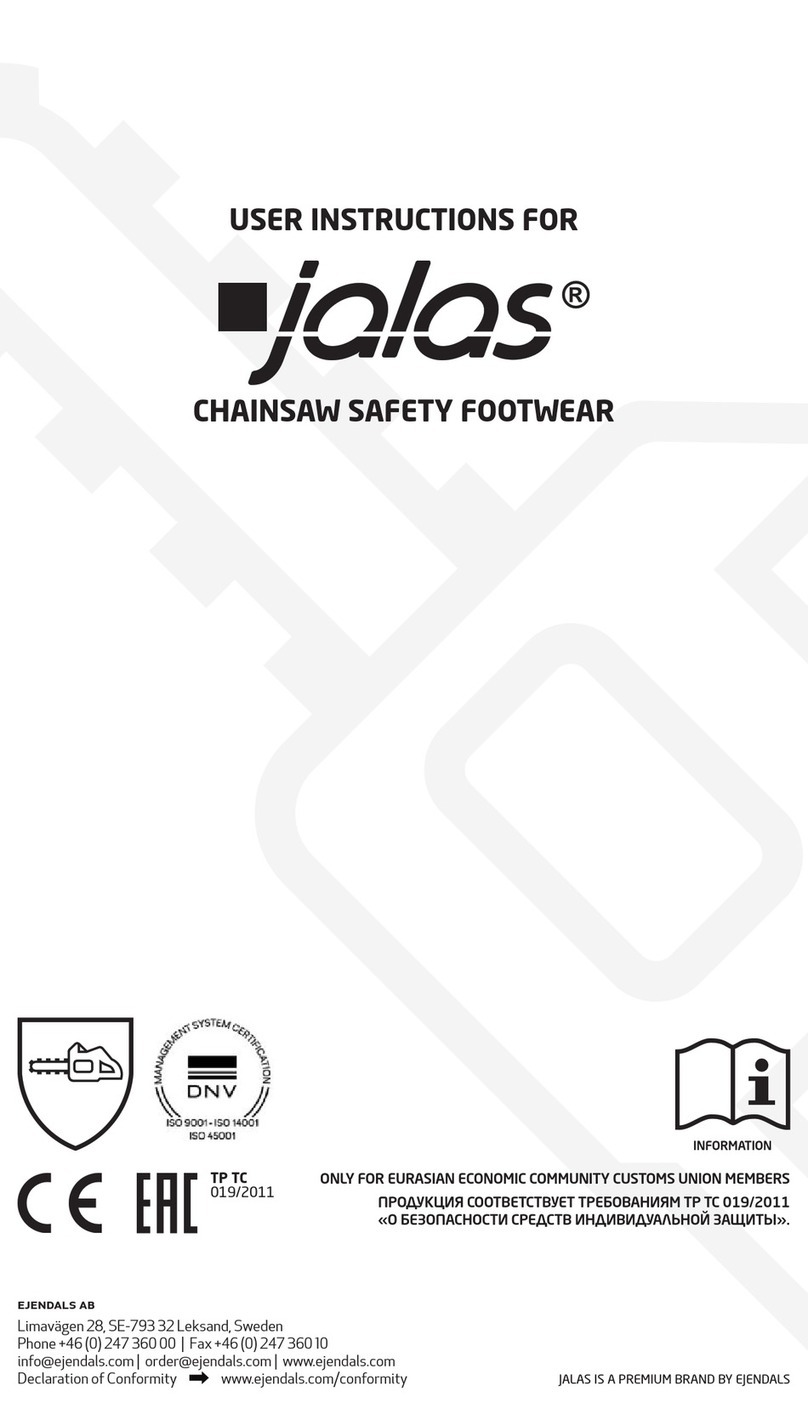
ejendals
ejendals jalas 20345 User instructions
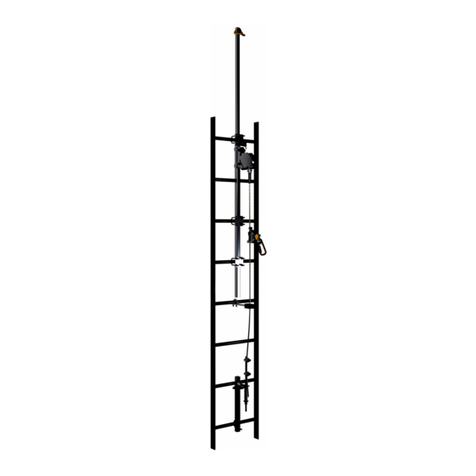
3M
3M DBI SALA OSHA 1926.502(d)(12) instruction manual

Petzl
Petzl SEQUOIA quick start guide
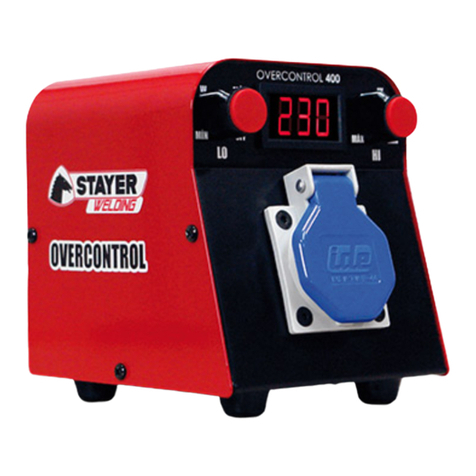
stayer
stayer OVERCONTROL 400 operating instructions

ETI Solid State Lighting
ETI Solid State Lighting EM-ELC-R Use and care guide
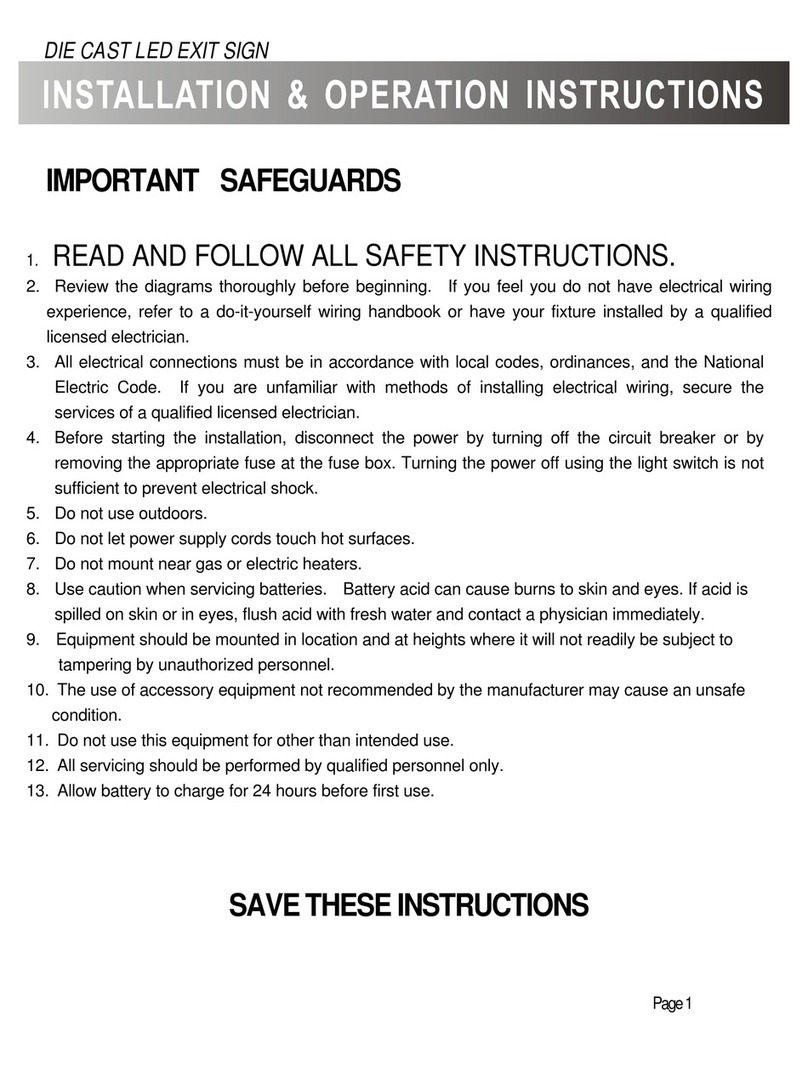
Nora Lighting
Nora Lighting NX-605 Installation & operation instructions

Falltech
Falltech 727630LE User instruction manual
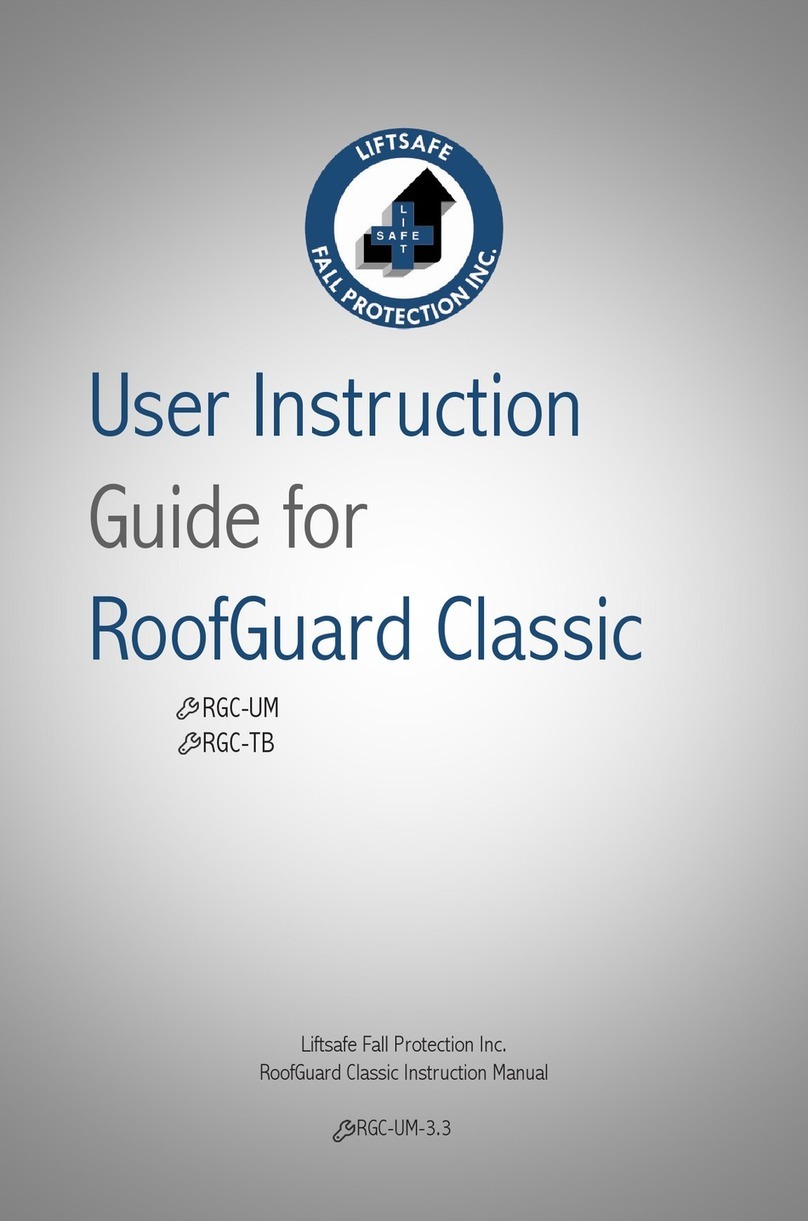
Liftsafe Fall Protection
Liftsafe Fall Protection RoofGuard Classic User instruction
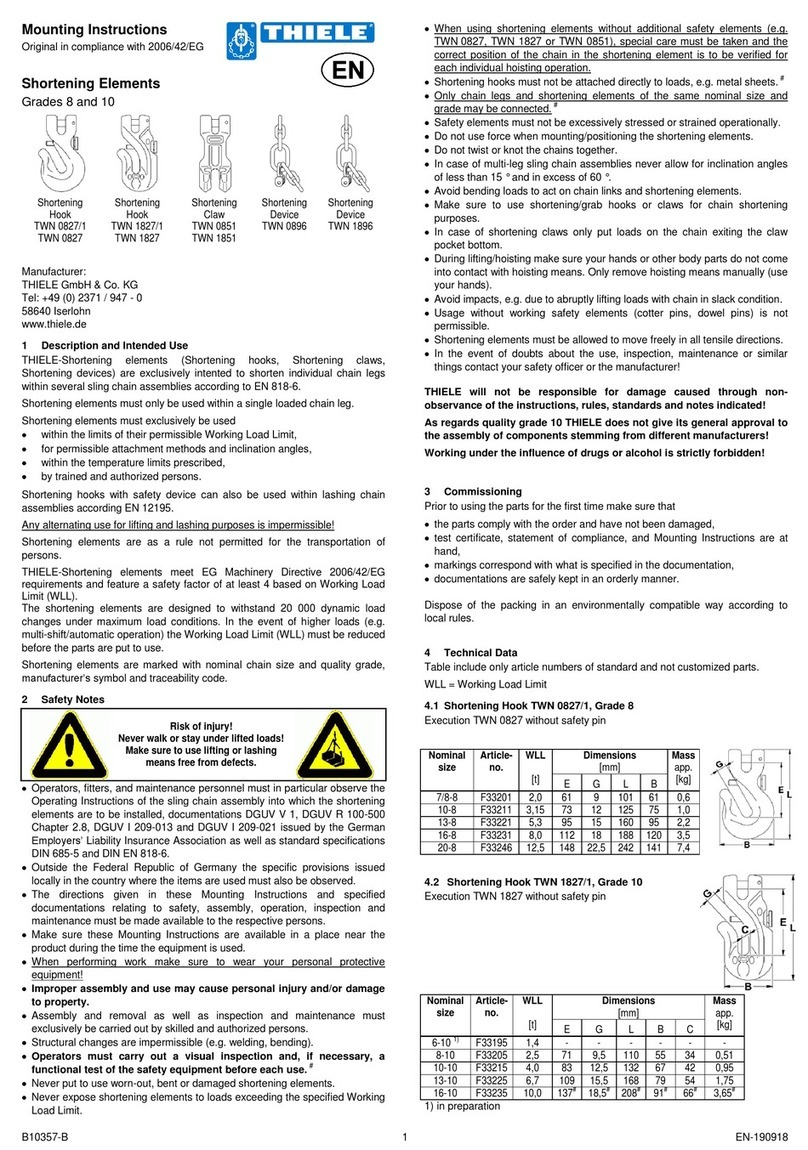
Thiele
Thiele TWN 0827/1 Mounting instructions
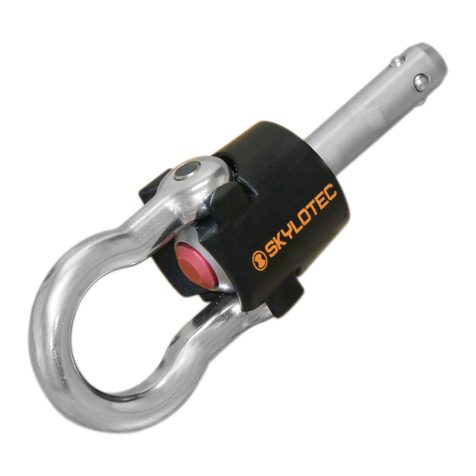
SKYLOTEC
SKYLOTEC MOBILFIX Assembly and operating instructions
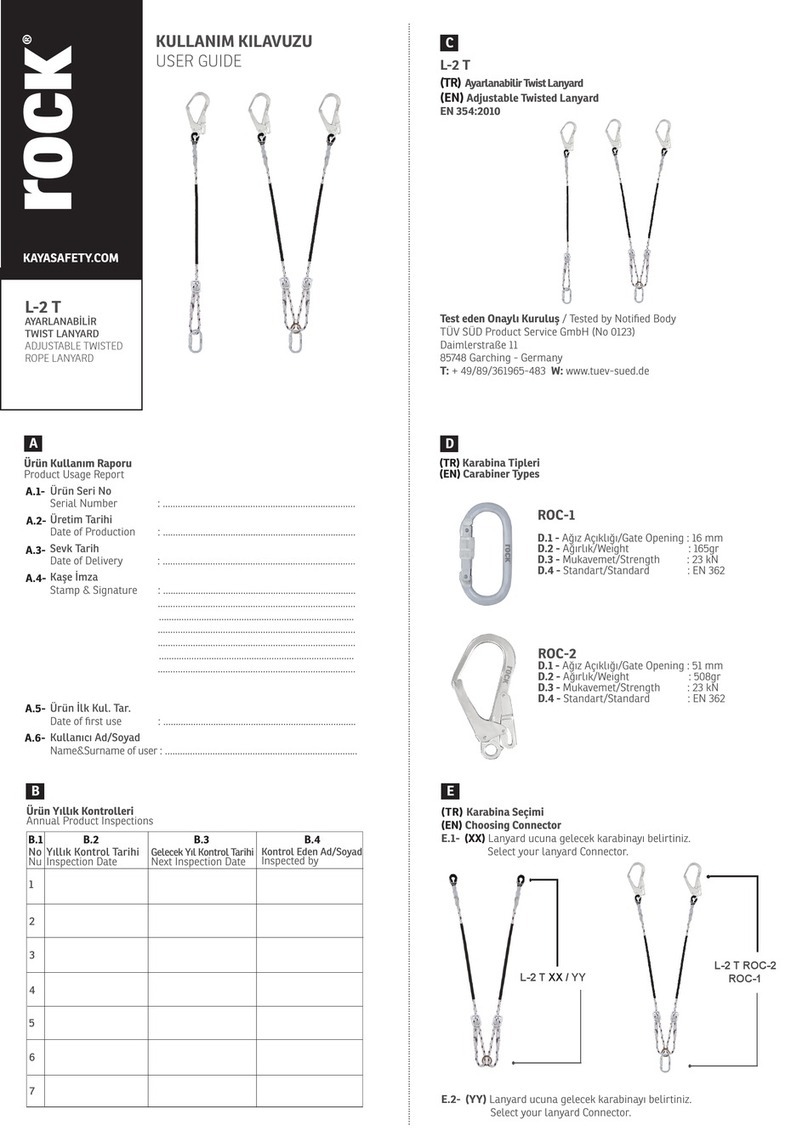
ROCK
ROCK L-2 T user guide
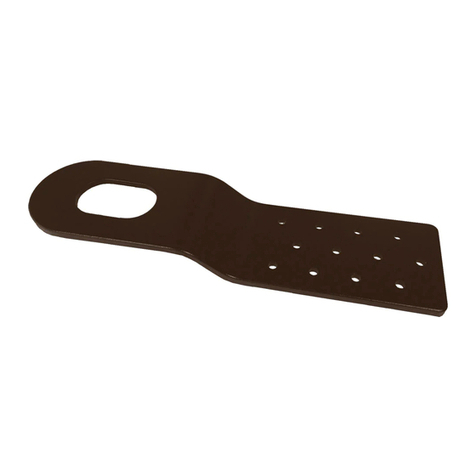
Guardian
Guardian PitchPro instruction manual
